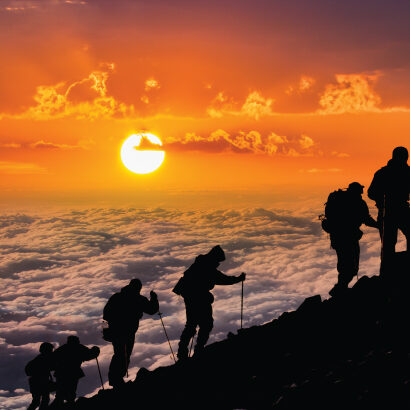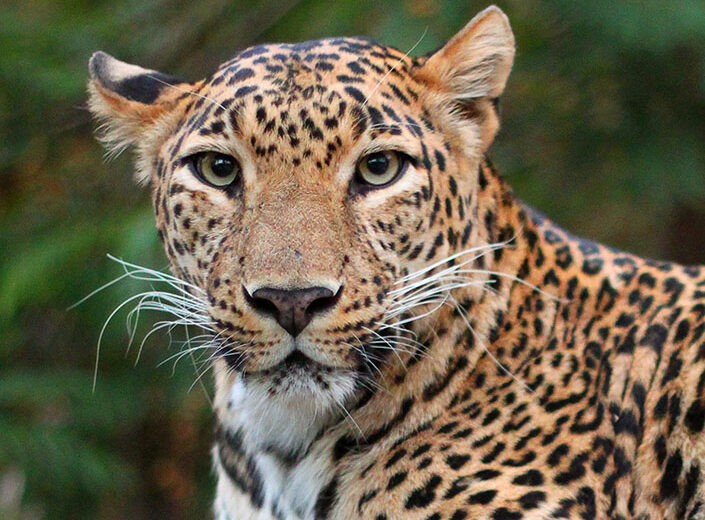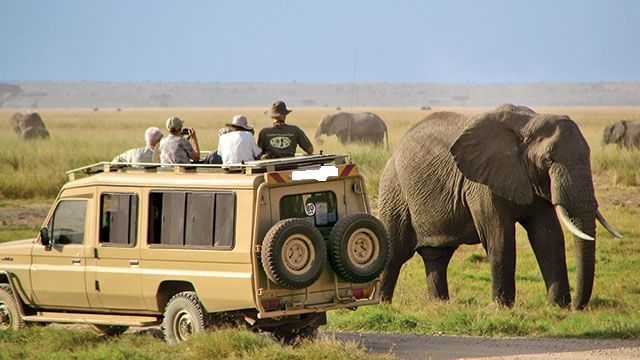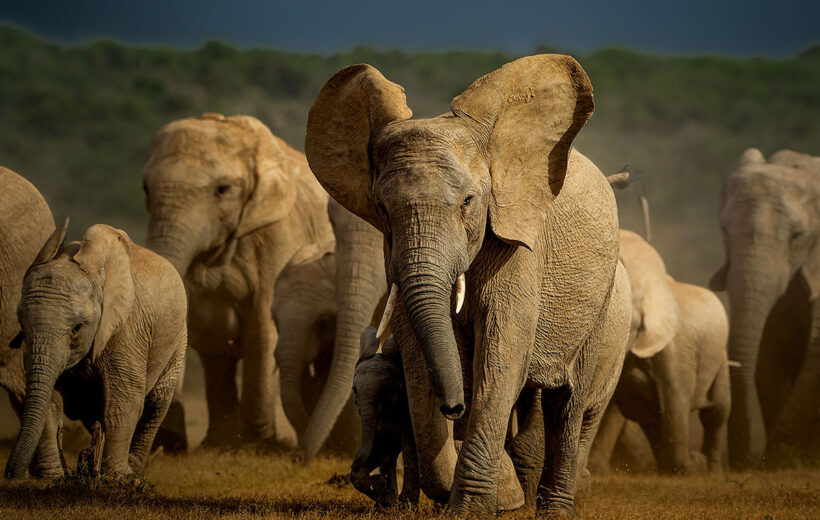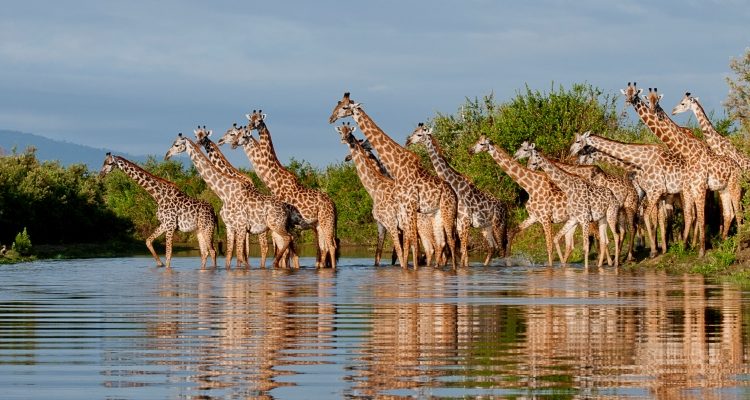Serengeti National Park-Tanzania
Serengeti National Park
Serengeti National Park, located in northern Tanzania, is one of the most iconic and celebrated wildlife destinations in the world. It covers an expansive area of approximately 14,763 square kilometers (5,700 square miles) and is part of the larger Serengeti Ecosystem, which also includes adjacent protected areas in Tanzania and Kenya. Here, the natural world comes alive, offering an extraordinary safari experience that's synonymous with Africa's untamed beauty and abundant wildlife.

Key features of Serengeti National Park
- Great Migration: The Serengeti is perhaps most famous for hosting the Great Migration, one of the most spectacular wildlife events on the planet. Every year, millions of wildebeests, zebras, and gazelles traverse the Serengeti plains in search of fresh grazing land and water, providing an awe-inspiring sight for visitors.
- The Big Five: The park is home to the "Big Five": African lions, African elephants, African leopards, African buffalo, and black rhinoceros. These iconic animals are a major draw for safari-goers.
- Diverse Wildlife: Beyond the Big Five, the Serengeti is rich in wildlife diversity, with over 70 species of large mammals and nearly 500 species of birds. Giraffes, cheetahs, hyenas, and numerous antelope species are among the park's residents.
- Predator-Prey Dynamics: The Serengeti is renowned for its predator-prey dynamics, particularly the dramatic interactions between big cats like lions, cheetahs, and leopards and their prey species. It's a unique opportunity to witness the circle of life in action.
- Balloon Safaris: Visitors can experience the Serengeti from a different perspective by taking a hot air balloon safari. This allows for panoramic views of the park's landscapes and wildlife.
- Landscapes: The Serengeti's landscapes vary from vast open savannahs to riverine forests and kopjes (rocky outcrops). Each area offers different opportunities for wildlife viewing and photography.
- Conservation: The park is a UNESCO World Heritage Site and plays a crucial role in the conservation of African wildlife. Efforts are ongoing to protect the park's unique ecosystems and combat poaching.
- Cultural Experiences: In addition to its natural wonders, the Serengeti provides opportunities to interact with local Maasai communities, learning about their traditional way of life and cultural heritage.
Best Time to Visit
- Overview
- Great Migration
- Dry Season
- Birdwatching
- Balloon Safaris
- Cultural Experiences
- Avoiding Crowds
- Accommodation
The best time to visit Serengeti National Park depends on your interests, whether you want to witness the Great Migration, focus on game viewing, enjoy birdwatching, or experience cultural interactions. Each season offers its own unique experiences, so plan your visit based on your preferences and priorities.
BEST TIME TO VISIT THE SERENGETI NATIONAL PARK
January to February:
-
- This marks the beginning of Tanzania’s green season, making it an excellent time for birdwatching as migratory bird species are present.
-
- The famous Great Wildebeest Migration concentrates in the Ndutu area during these months, as it’s calving season when wildebeests give birth.
March:
-
- March is a transitional period, with the weather being uncertain, as it’s neither clearly dry nor the start of the rainy season.
-
- It’s almost the end of the wildebeest calving season in the Ndutu area.
April to May:
-
- These months are the rainy season, making it challenging to move around and enjoy the sun.
-
- The migration is expected to be in the south or central Serengeti.
-
- Fewer travelers visit during this period.
June to August:
-
- This is the beginning of the dry season and the peak season for safari visitors.
-
- In June, the Great Migration crosses the Grumeti River in the western Serengeti.
-
- The Great Migration makes its way north toward the Mara River for dramatic river crossings into the Masai Mara Reserve.
September to October:
-
- Still part of the dry season, these months see a reduction in the number of travelers.
-
- The Great Migration is expected to be in the Maasai Mara in Kenya.
November to December:
-
- This period experiences short rains.
-
- There are few travelers, with a small peak season from late December to early January.
-
- The migration returns, making its way to the south Serengeti and north Ngorongoro.
To witness the Great Migration, visit between December and July when the wildebeests and zebras are on the move. The precise timing can vary each year.
-
- If your primary goal is to witness the Great Migration of wildebeests and zebras, you should plan your visit between December and July. During this period, the herds move through the Serengeti in search of fresh grazing land, with calving season occurring from January to March in the southern Serengeti.
-
- The exact timing of the migration can vary each year, so it’s essential to keep updated with the latest information from local guides and park authorities.
The Wildebeest Migration by Numbers:
Determining the exact number of migratory animals in the Serengeti is challenging, but estimates suggest an astonishing population of:
-
- Over 1.4 million wildebeests
-
- More than 350,000 zebras
-
- Over 300,000 gazelles (including Thomson’s and Grant’s gazelles)
-
- More than 6,000 acres
Why the Serengeti Migration Occurs—The Purpose of Wildebeest Migration:
The Serengeti migration is a fundamental survival strategy for these animals. It revolves around several key factors:
-
- Green Pastures and Water: The migratory animals follow the path of rainfall and lush vegetation. They migrate to find greener pastures and access to water sources, which are vital for their survival and sustenance.
-
- Mineral-Enriched Plains and Short Grass: During the calving season, these animals move to mineral-enriched plains in southern Serengeti and northern Ngorongoro. These areas provide essential minerals for their bones and bodies while they give birth and nurture their newborns. The short grasses in these regions are strategic, allowing them to spot predators more easily.
-
- Western and Northern Corridor: When the dry season sets in, the animals move to the western and northern corridors of Serengeti. Unlike the open plains, these areas have trees and bushes that are less affected by drought, providing some respite during harsh conditions.
Why Migration Animals Move Together:
The great wildebeest migration involves wildebeests, zebras, gazelles, and elands moving together. While they share a common goal of finding green pastures and water, their alliance has other benefits:
-
- Wildebeests possess a keen sense of smell and instincts for following rain patterns, aiding other animals in locating fertile areas.
-
- Zebras and other species have better vision, helping alert the herds to potential dangers posed by predators. This collective vigilance enhances their chances of survival.
Best Time to Witness the Serengeti Wildebeest Migration 2021-2022:
The great wildebeest migration is a spectacular annual event, and travelers often debate the best time to witness this natural wonder. The migration is marked by several highlights:
Calving Season (December to March):
-
- During this period, wildebeests, zebras, and other migratory animals give birth and nurture their newborns.
-
- This takes place in southern Serengeti and northern Ngorongoro, particularly in the “Ndutu” area.
-
- This region is mineral-enriched with short grass, making it an ideal place for calving and attracting predators for live hunting sightings.
Choosing when to visit the Serengeti depends on the specific experiences you seek, whether it’s witnessing the birth of new life or observing dramatic predator-prey interactions during other phases of the migration.
Why does the Serengeti migration occur, and why does the wildebeest migrate?
The wildebeest migration encompasses the vast landscapes of the Serengeti, Maasai Mara, Ngorongoro, Maswa, and Loliondo regions out of necessity. This migration is not just a spectacle; it’s a fundamental aspect of their survival. These resilient animals consume a staggering 4000 tons of vegetation daily, which necessitates their constant movement and feeding. They follow the lead of the wildebeests, whose acute sense of smell and instinct can discern the presence of rainfall.
Their migration serves the purpose of seeking out ecosystems that are favorable for their survival. This journey is driven by the pursuit of:
1. Green Pastures and Water: The migratory herds are perpetually in search of lush, green pastures and accessible water sources, both of which are essential for their sustenance. Their nomadic lifestyle ensures they always find fresh feeding grounds.
2. Mineral-Enriched Plains and Short Grass: During the calving season, these animals venture into the mineral-enriched plains of southern Serengeti and northern Ngorongoro. Here, they obtain crucial minerals vital for the development of their bones and overall health. The presence of short grass in these regions is strategic, aiding them in detecting potential predators, especially when vulnerable young are being born and nurtured.
3. Western and Northern Corridor: As the Serengeti region dries up, the herds instinctively move towards the western and northern corridors. Unlike the expansive plains, these areas offer the advantage of trees and bushes, which remain more resilient during times of drought. It’s a strategic move that ensures their survival in challenging conditions.
In essence, the wildebeest migration is an epic journey that revolves around the basic needs of these animals: food, water, minerals, safety for calving, and adaptability to changing environmental conditions. It’s a testament to the remarkable strategies that nature has crafted to ensure the survival of these magnificent creatures in the heart of Africa.
Why do the migration animals move together?
The great wildebeest migration unites various species, including wildebeest, zebras, gazelles, and elands, in a remarkable display of cooperation. Their shared objective is simple yet crucial: finding greener pastures and water sources. However, beyond this common goal, these animals form a strategic alliance.
For instance, wildebeests possess an extraordinary sense of smell and innate instincts that guide them in tracking rainfall patterns. This ability significantly benefits other animals, as they can follow the wildebeest to locate fertile grazing lands. Meanwhile, zebras and other members of the alliance contribute with their exceptional vision, serving as the sentinels of the group. Their keen eyesight allows them to detect potential threats posed by predators, ensuring the safety of the entire herd.
In essence, this collaboration among different species exemplifies the synergy of nature, where each animal’s unique strengths and abilities complement those of the others, ultimately enhancing their collective chances of survival in the challenging African wilderness.
The Serengeti wildebeest migration cycle & Map
The remarkable Serengeti wildebeest migration unfolds year after year, following a well-known path or cycle. While the general sequence of this migration can be predicted, precise timings may vary due to weather-related factors. Nonetheless, it typically falls within a particular time range.
December to March: During this period, the migration witnesses a substantial concentration of herds in the southern Serengeti and northern Serengeti regions, notably in the renowned Ndutu area. This is the season of calving, where many wildebeest give birth. However, some herds may also be found in scattered locations such as Naabi, Olduvai, and Gol, which are situated in the south Serengeti and north Ngorongoro areas.
April to July: Starting in late March, the herds commence their journey from the south Serengeti to the central Serengeti, specifically the Seronera region. Here, they establish their presence before gradually progressing towards Kirawira and Grumeti in the western Serengeti by late May. A striking spectacle occurs when they cross the Grumeti River, which typically takes place from mid-June to July.
July to September: In July, the herds shift to the northern reaches of the Serengeti, including Kogatende and Lobo. Some herds continue their migration across the Mara River and into the Masai Mara in Kenya. This northward movement often extends into early October.
October to November: During this phase, the last herds usually arrive in the Masai Mara, where they graze until November. Subsequently, they embark on their return journey back to the Serengeti.
The Serengeti wildebeest migration is a cyclical masterpiece of nature, a perpetual quest for sustenance, and a symbol of the enduring rhythms of life on the African plains. While exact timings may fluctuate, the grand spectacle of this migration is a testament to the timeless wonders of the natural world.
Key Insights into Migration Tour Packages:
When considering a migration tour package, here are essential details to keep in mind:
1. Diverse Itinerary: While the primary focus of this tour is the awe-inspiring migration, it also encompasses visits to other must-see attractions, including the iconic Ngorongoro Crater.
2. Varied Accommodations: Expect to stay in a range of accommodations that enhance the safari experience. This may include tented lodges, mobile camps, seasonal tented lodges, and traditional lodges. Customization is possible based on your preferences.
3. Private Tours: These tours are private, ensuring an exclusive and personalized experience. Travelers are not grouped together, as the accommodations are not budget-oriented, and the nature of the safari can be challenging and risky.
4. Tailor-Made Experiences: Flexibility is a hallmark of these tours. Clients have the option to tailor their experience by incorporating add-on features and customizing aspects to align with their unique preferences and interests.
Fascinating Facts about the Serengeti Wildebeest Migration:
When witnessing the Serengeti wildebeest migration, consider these astounding facts:
-
- This migration ranks as the largest animal migration on Earth, featuring over 2 million animals in motion.
-
- The migrating herds collectively consume an astonishing 4000 tons of food every day as they traverse the savannah.
-
- Unlike traditional animal migrations, there is no single leader guiding the way. Instead, it’s a collective endeavor driven by instinct.
-
- During a span of just a few weeks, approximately half a million newborns are welcomed into the world amid the migration.
-
- These resilient newborns can walk and run within minutes of their birth, showcasing nature’s remarkable adaptation.
-
- The migration covers a staggering distance, forming a circular route spanning over 1000 kilometers. This continuous journey is a testament to the endurance and tenacity of these remarkable animals.
Embarking on a migration tour offers not only a chance to witness this remarkable spectacle but also an opportunity to be part of the untamed rhythms of the Serengeti, where nature’s grandeur unfolds before your eyes.
For optimal game viewing, consider visiting during the dry season from late June to October. The animals congregate around water sources, making them easier to spot.
- For the best game viewing and wildlife sightings, consider visiting during the dry season, which typically runs from late June to October. During this time, the vegetation is less dense, and animals congregate around water sources, making them easier to spot.
- The dry season is also when predators are particularly active, as they take advantage of the concentrated prey.
Birdwatchers will find the wet season (November to May) rewarding, as migratory bird species are present.
- Birdwatchers should plan their visit during the wet season, which spans from November to May. Migratory bird species are present during this time, offering excellent opportunities for birdwatching.
- The lush green landscapes during the wet season also provide a beautiful backdrop for photography.
If you’re interested in taking a hot air balloon safari for panoramic views of the Serengeti, these are typically available year-round, but the experience may vary with the seasons.
Serengeti Balloon safaris in Tanzania
Embarking on a skyward safari, devoid of traditional road tracks, promises an extraordinary and unforgettable adventure. Serengeti balloon safaris offer a truly unique and once-in-a-lifetime experience.
In our commitment to delivering the most exceptional experiences, we have established partnerships with the finest balloon safari providers in Tanzania. This collaboration ensures that our clients can partake in this remarkable journey at the most competitive rates while enjoying unparalleled convenience.
It’s worth noting that these balloon providers operate exclusively within the national parks. Therefore, booking your balloon safari through us not only secures you an advantageous rate but also guarantees seamless logistics and unmatched convenience throughout your Serengeti adventure
.
What sets Serengeti Balloon safaris Apart?
Experience the Serengeti from a Majestic Perspective.
Explore the vast Serengeti plains from a breathtaking bird’s eye view. Soaring over the landscape at an altitude exceeding 3000 feet provides a truly unparalleled sight of the land below, especially on a clear day. The sensation is utterly worth it as you gain a unique vantage point to witness the intricate details of this iconic wilderness. It’s an extraordinary way to immerse yourself in the wonder of a wildebeest migration safari in the Serengeti.
Witness unforgettable sunrise moments.
The Serengeti boasts some of the world’s most remarkable sunrises and sunsets. A hot air balloon safari grants you the opportunity to witness the early morning magic as the sun gracefully ascends. Since night game drives are not permitted in the Serengeti National Park, embarking on a hot air balloon adventure offers an extra advantage. You’ll travel from your lodge to the balloon in the pre-dawn darkness, ascending just as the first light of day breaks. This provides an excellent chance to spot nocturnal animals that remain elusive during daylight hours.
A memorable landing celebration
Upon landing, a special ceremony awaits you. You’ll be presented with an honorary certificate to commemorate your exhilarating journey. A champagne toast adds a touch of elegance to the occasion. Afterward, you’ll be driven to join your fellow balloonists for a delightful full English breakfast, prepared amidst the picturesque Serengeti bush. It’s a remarkable conclusion to an unforgettable adventure, etching lifelong memories of your Serengeti balloon safari.
Selecting Your Flight Destination:
When choosing where to embark on your extraordinary balloon safari adventure, consider the following options:
Seronera, Central Serengeti: This location offers year-round ballooning opportunities, but for an added spectacle, consider visiting during the peak of the great migration in the central Serengeti.
Kogatende, North Serengeti: From July to November, Kogatende is the ideal launch point for those eager to track the great wildebeest migration as it unfolds in the northern Serengeti.
Kirawira, West Serengeti: For an exceptional experience of the migration’s western phase, plan your flight from Kirawira between June and September, capturing the breathtaking sight of wildebeests journeying through the west Serengeti.
Ndutu, South Serengeti/North Ngorongoro: If witnessing the extraordinary calving season of the great migration is your goal, then plan your flight from Ndutu between December and March. Here, you’ll follow the herds as they gather in this region for this remarkable event.
Tarangire: Located in northern Tanzania, Tarangire National Park is a year-round ballooning destination, offering breathtaking aerial views and wildlife encounters at any time of the year.
Ruaha: In the southern reaches of Tanzania lies Ruaha National Park. Balloon flights are available here from July to August, coinciding with peak safari season and making it an economically viable choice for balloon safari providers.
Selecting the right flight destination ensures you’ll witness the Serengeti and its extraordinary wildlife at the most opportune moments, enhancing your balloon safari experience to the fullest.
Balloon Safari Costs in Tanzania:
-
- Standard Package: Priced at $570 per person, this package provides a captivating flight experience lasting approximately 1 hour to 1 hour and 15 minutes. The entire journey, from your lodge pick-up to the post-flight wine celebration and return to the lodge, spans nearly 5 hours.
-
- Honeymoon Package: Tailored for couples, the honeymoon package is available at $4500 for two individuals. It offers an extended flight duration, ranging from 1 hour and 15 minutes to 1 and a half hours. As with the standard package, the entire adventure encompasses around 5 hours, from lodge pick-up to post-flight wine celebrations and your return to the lodge.
These balloon safari packages provide an enchanting and unforgettable aerial perspective of Tanzania’s magnificent landscapes and wildlife, ensuring an experience that will be cherished for a lifetime.
Serengeti Balloon Safari Itinerary:
From Your Camp to the Balloon:
04:00 – 05:15 AM
Some experiences are worth the early rise, and this is undoubtedly one of them. Your journey commences before daybreak, departing from your Serengeti camp in the tranquil pre-dawn silence. The anticipation heightens as you embark on this nocturnal game drive, perhaps catching a glimpse of one of the Serengeti’s elusive creatures in the headlights.
Keeping Safe & Preparing to Fly:
06:15 – 06:45 AM
Your experienced pilot conducts a crucial safety briefing as the sky gradually lightens and the balloon’s crew begins the inflation process. As the envelope of the balloon takes shape, billowing in shades of savannah gold and acacia green, illuminated by the burner flames, you step into the basket, preparing for your ascent into the dawn.
Serengeti from the Sky:
06:45 – 08:15 AM
Each flight is a unique journey guided by the wind’s direction, where sights and sounds rise from the ground to greet you. While you know your starting point, your return location remains uncertain, adding to the adventure. Sometimes, the basket gently grazes the grass tips before ascending through layers of air, offering a view of the golden and pink-hued horizon. Our skilled pilots not only harness the African wind with expertise but also interpret the wildlife’s movements in the landscape below. After approximately an hour in the sky, the basket gracefully returns to the Serengeti plains, but the adventure continues.
Celebrating a Tradition:
08:15 – 08:30 AM
“As the winds have welcomed you with softness and the sun has blessed you with its warm hands…” It is customary for balloonists to celebrate their flight with a toast of bubbly. A short walk or drive from your landing spot brings you to a moment where you raise a glass to your soaring adventure. From here, we attend to earthly matters and transport you to a unique Serengeti breakfast setting.
Meeting Hunger with Plenty:
08:30 – 09:30 AM
There is truly nothing that compares to breakfast beneath the expansive canopy of an acacia tree in the heart of the Serengeti plains. Enjoy tropical fruits, freshly baked bread, and eggs prepared in the wilderness, their flavors enhanced by the extraordinary surroundings. This breakfast, served on fine linen, bone china, and Sheffield cutlery, exudes an “out of Africa” ambiance. Shoulder to shoulder with fellow passengers, savor this moment as you reflect on the remarkable flight you’ve just experienced.
Who can fly
Important Guidelines and Factors for Serengeti Balloon Safaris:
Age Restrictions:
-
- Children between 5 and 7 years old must be accompanied by an adult during the balloon safari.
-
- Participants aged 7 and above can join the adventure independently.
Weight and Space Considerations:
-
- Passengers weighing over 120kg may be required to pay a supplemental fee due to weight and space restrictions.
Safety Precautions:
-
- For safety reasons, pregnant women are not permitted to take part in the balloon safari. This precaution is in place to ensure a smooth and safe landing experience.
Height Requirement:
-
- Participants should be at least 1.2 meters (3.9 feet) tall to partake in the balloon safari.
Reasons for Higher Costs of Serengeti Balloon Safaris:
-
- Balloon safaris in Tanzania, particularly in the Serengeti, incur higher costs compared to similar experiences in other locations. This is primarily due to the following factors:
-
- Operating Inside Protected Parks: Balloon safaris in Tanzania take place within national parks, which necessitate additional expenses such as equipment fees, crew fees, and other taxes.
-
- Concession Fees: A portion of the safari price contributes to concession fees paid to the park authorities for the privilege of conducting balloon safaris within their boundaries.
-
- Gas Transportation: The gas required for the balloons is transported over a distance of approximately 1000 kilometers to reach the park. This logistical challenge adds to the overall cost.
-
- Remote Lodge Pick-Up: Many lodges in the Serengeti are located in remote areas, requiring extensive travel to reach the launch site, which contributes to logistical and transportation expenses.
-
- Administrative Costs: Other administrative costs associated with organizing and operating balloon safaris also contribute to the overall pricing.
-
- Balloon safaris in Tanzania, particularly in the Serengeti, incur higher costs compared to similar experiences in other locations. This is primarily due to the following factors:
These factors collectively account for the higher costs associated with Serengeti balloon safaris, ensuring that participants experience a safe and memorable adventure within the stunning African wilderness.
For cultural experiences and interactions with local Maasai communities, you can visit the Serengeti throughout the year. However, it’s a good idea to check with local communities to find out if there are specific cultural events or festivals happening during your intended visit.
If you prefer to avoid larger crowds, consider visiting during the shoulder seasons, which are the transitional periods between the wet and dry seasons (March to May and November). Accommodation prices may also be more favorable during these times.
Where to Visit and Stay in Serengeti National Park:
Serengeti National Park offers a wide range of accommodation options to suit various budgets and preferences, ensuring a comfortable and immersive safari experience. These accommodations are strategically located throughout the park, with many situated in the central Serengeti region.
Accommodation styles in Serengeti National Park:
-
- Public Camping: Serengeti National Park provides public campsites for budget-conscious travelers. These campsites offer basic facilities and are a great option for those looking for an authentic camping experience.
-
- Special Camping: Special campsites are available for those seeking a more secluded and private camping experience. These campsites often provide exclusive access to certain areas of the park.
-
- Seasonal Lodges: Some lodges in the Serengeti operate seasonally, opening during peak tourist seasons. They offer comfortable accommodations and are typically open during the dry season, when visitor numbers are high.
-
- Tented Lodges: Tented lodges provide a unique blend of luxury and the feeling of being close to nature. These accommodations offer spacious tents with en-suite facilities, providing a comfortable and immersive safari experience.
-
- Lodges: Serengeti lodges offer a high level of comfort and convenience. They are often well-appointed with modern amenities, providing a luxurious and relaxing retreat after a day of safari adventures.
Considerations for Serengeti Accommodations:
-
- Accommodation in Serengeti National Park tends to be relatively expensive due to the logistical challenges of importing food and supplies. Additionally, various licenses and taxes are applied to accommodations within the park.
-
- Choosing the right place to stay in Serengeti can be overwhelming, as the park is vast and different activities and wildlife sightings occur at different times of the year, depending on the season.
-
- To make the most of your Serengeti safari experience, it’s essential to research and plan your stay based on your interests, the time of year you’ll be visiting, and your budget. This will ensure you have a memorable and enjoyable adventure in this incredible wildlife sanctuary.

